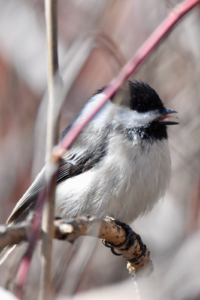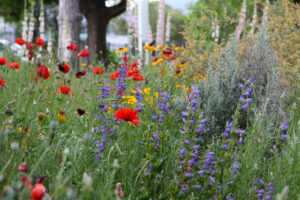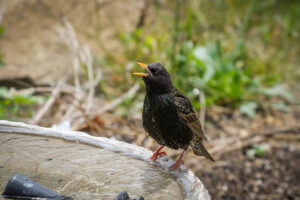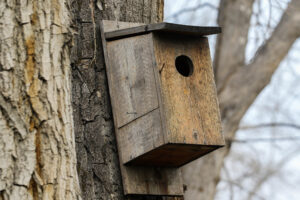Song of the Chickadee: Gardening for Birds, Bees, and Other Wildlife

By Parker Lloyd
Though the wind still bites, snow has (mostly) turned to rain. Sunrise comes an hour late. Amethyst petals emerge from dry lawns, beating the grass to the sunlight dancing across dew suspended from a subtly striped crocus—a bee crashlands, imbibing on critical resources concealed in these petals. And up above, a quiet chirp abruptly turns into a familiar “Dee-dee,” “Dee-dee-dee.” Spring is on the horizon, and the Chickadee is on the move.

The black-capped Chickadee (Poeciles atricapillus) is a familiar bird to the most novice naturalist, backyard denizen, or casual wonderer. Its mournful cries for “Cheeseburger” inspire gut-wrenching nostalgia, and the song for which this tiny beast is named reminds us what it is called. Black-capped Chickadees are cavity nesters, meaning they will find a hollowed branch or rotten tree to lay their eggs. Clutch sizes vary, but eight tiny mouths would not be unexpected. Like ourselves, the Chickadee is omnivorous. They survive the winter by eating seeds, pecking at crabapples, and consuming persistent berries. But with spring comes a proliferation of resources, including their favorite food: caterpillars. These malleable, soft-bodied delicacies are perfect to feed a tiny hatchling, each time feasting as if for the first time. Both parents work together to collect five hundred caterpillars a day to nourish their young, who will have consumed over nine thousand caterpillars by the time this 16-day cycle is complete.
Where do these caterpillars come from? For a single pair of Chickadees to successfully raise their young, they must nest within reach of host plants capable of supporting thousands of insects. Host plants have relationships with organisms, like insects, to provide specific resources like food or shelter, such as the relationship between the Monarch Butterfly (Danaus plexippus) and Milkweed (Asclepias spp.). While countless species of native plants host insects, some trees, such as Gambel Oaks (Quercus gambelii), can be veritable condominiums, uncommonly dense and numerous with caterpillars.
Beyond this succulent baby food, the Chickadee needs specific resources in such abundance as to support themselves and provide for subsequent generations. In the case of the Chickadee, this means dead branches (called snags) for nesting, native plants – such as Gambel Oak, and seed-bearing annuals that provide year-round food – and a water source. In the Wasatch foothills, these resources are abundant. For wildlife, meticulously maintained yards can be sterile wastelands with minimal habitat or resources. Civilization necessitates we cut out dangerous snags, compost flammable stems, and remove standing water with vigilance. Roads fracture migration corridors for mule deer, and historic fields of wildflowers become parking lots. Some species benefit from urbanization to the chagrin of their less adaptable neighbors; in the Southwest, Desert Tortoise hatchlings are eaten by ravens able to expedition far deeper into the desert than historically possible thanks to unattended dumpsters.
All wildlife requires three key resources: food, water, and shelter. At home, we can take humble actions to support urban wildlife’s oft-difficult, tumultuous existence.
- Cultivating a pollinator garden full of native wildflowers provides insects with one key resource: food. While appropriate species vary depending on your yard’s unique climate and conditions, the impact of planting native will be the same regardless. Native plants attract native insects, and some of these bugs will go on to feed the ravenous Chickadee. Yet more birds will depend on your garden’s lifeline of resilient seeds clinging to dry stems in the dead of winter. Placing bird feeders stocked with variable foods will feed a variety of bird species, which will feed a variety of raptors.

2. A bird bath or shallow water bowl covers the next resource: water. Placing pebbles inside the bowl will improve its accessibility to tiny insects. Regularly replacing the water keeps it clear of pests and healthy for wildlife.

3. The final resource is shelter. These can be elaborate bee hotels, birdhouses, and bat boxes or a thoughtfully planned and intentionally neglected garden. Birds like the Chickadee will nest in dead branches lined with debris collected from your gardens. Queen bumblebees quietly sleep in what little warmth can be found in last autumn’s fallen leaves, waiting for the perfect conditions to emerge before establishing a colony in an abandoned burrow near a bit of bare earth. The dry, pithy stems of sunflowers, their hollow skeletons a stark antithesis of their cheery summer glow, house numerous insects, a few becoming food to a Downy Woodpecker; simply allowing your yard to be a little “messy” will best impact wildlife.

As spring shows itself with greater fervor, consider the actions we can take in our backyards to respect all our neighbors, whether the humans next door or a ravenous Chickadee.